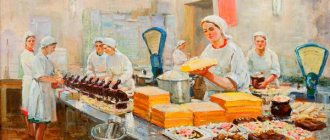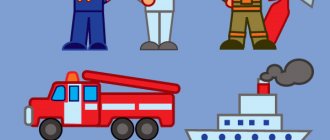Calendar-thematic planning in the preparatory group on the topic “Furniture” “
Furniture theme
The content of the work:
Expand and systematize children’s ideas about pieces of furniture and their purpose, its functions and properties, the quality of the materials from which it is made, its diversity.
Develop the ability to distinguish and name furniture parts.
Fix the general concept of “furniture”.
To develop children’s ability to describe pieces of furniture based on a model.
Expanding children's ideas about objects in their immediate environment, their purpose, continue to show different ways of examining household objects, actively include hand movements on the object and its parts.
Formation of the ability to group and classify.
Implementation period
: from January 28 to February 1
Final event:
craft competition “Furniture for dolls” (together with parents)
28 January. Monday.
Morning.
Conversation “What is furniture for?».
Goal: formation of generalized ideas about pieces of furniture, their functions; practice formulating a motivated answer; formation of mental operations of analysis, synthesis and comparison;
Didactic game "The third wheel". Goal: to consolidate the general concept of “furniture” in the dictionary. Introduce children to polysemantic words.
Individual work with Vika, Dinara.
Didactic game “ABC of sounds”.
Goal: to develop the ability to name and highlight sounds in words.
Experiments with water. Goal: to develop children’s ability to determine the volume of liquid using a conventional measure
Labor - duty in a corner of nature: wash flowers. Goal: to teach to carefully carry out orders.
OOD
1.Speech therapy
2. Cognitive development.
Theme "Furniture in my home"
Integration: cognitive development, speech development.
Goal: expanding children's understanding of furniture, the names of its parts, and the material from which it is made.
Tasks:
Correctional and educational:
Discuss with children the names and functions of furniture, its parts, how to care for furniture, and consolidate the general word “furniture.”
Expand children's knowledge about the purpose of furniture in human life, about its various types.
Correctional and developmental
:
Develop logical thinking, attention, memory, perseverance in class.
Correctional and educational:
Foster respect for the work of adults and respect for furniture.
Preliminary work: examination of furniture, conversations on the topic.
Vocabulary: mezzanine, doors, tabletop.
Teaching aids: pictures of furniture, sheets of paper, pencils.
3. Artistic and aesthetic development (music)
Walk
No. 25. Individual work with Roma, Yaroslav P..
2 half day.
Role-playing game “Furniture Salon”: plot “Sale”. Goal: to develop the ability to include personal knowledge about the work of cashiers, managers, and store departments in furniture classification into the plot of the game ;
diversify the game situation “Furniture Delivery”.
Reading the poem by S. Marshak “Where did the table come from?” Learning a fragment.
Goal: to develop children’s ability to emotionally perceive the figurative content of a poem, to develop the ability to expressively read a poem by heart.
Walk
No. 16 (repetition). Individual work with Alina, Vika.
Outdoor game “Quickly take it, quickly put it down.”
Goal: to help improve children’s performance of game actions, to develop the ability to compare their actions with the rules of the game.
Didactic game “Draw by dots”. Goal: develop fine motor skills.
Learning the poem “Reader” by V. Berestov Goal: to arouse children’s interest in V. Berestov’s poem “Reader”, consolidate the skill of using diagrams when memorizing a poem;
Working with parents. Informing parents about the progress of the educational process, encouraging them to read works of fiction together with their child.
January 29. Tuesday
Morning.
Conversation “My room”».
Goal: to consolidate the names of pieces of furniture, to develop the ability to correctly name its parts. Examination of photo illustrations depicting cabinet and upholstered furniture.
Didactic game "It was - it will be." Goal: to clarify children’s ideas about the past, present, and future time, to develop time orientation.
Canteen duty (Timofey, Tamerlane). Goal: discuss with children the significance of the work being performed, develop the ability to plan their actions, stick to the plan, talk about the results of the work, and evaluate its quality.
Didactic exercise “We read.” Goal: to exercise Tagir and Timofey in composing and reading syllables.
OOD
1.Speech therapy
2.Cognitive development (FEMP)
Subject: «
Number 19, orientation in space, logical problem, geometric shapes.”
Integration: cognitive, artistic and aesthetic development.
Target:
formation of the basic elements of cognitive activity.
Tasks.
Correctional educational tasks.
Introduce the formation of the number 19.
Strengthen the ability to write the number 19.
Strengthen the ability to form the number 10 from two smaller numbers;
Strengthen the ability to compare objects by size using comparison results (large, smaller, short, shorter, etc.)
Continue to develop the ability to solve a logical problem.
Corrective and developmental tasks
Develop logical thinking, memory, attention.
Develop the ability to understand a learning task and complete it independently;
Correctional and educational tasks
Cultivate interest in OOD.
Strengthen the skills of self-control and self-esteem
Preliminary work:
solving problems, guessing riddles, working in copybooks, in squared notebooks.
Teaching aids: workbooks, colored and simple pencils.
3.Physical development
Topic: Standing long jump. Crawl under arches on all fours. Throwing the ball up."
Integration: physical, social and communicative development.
Goal: development of motor activity. Tasks.
Correctional and educational
Exercise children in walking and running in circles; learn standing long jump.
Practice crawling on all fours, rolling the ball in front of you with your head.
Correctional and developmental
Develop balance, dexterity, motor skills.
Develop motor activity.
Correctional and educational.
Cultivate endurance and the need for physical exercise.
Preliminary work. Ball games, outdoor game "Owl".
Equipment: long cord (rope), arches, balls.
Walk
No. 26. Individual work with Tagir, Violetta.
2 half day.
Riddles - answers. Goal: to continue to develop children’s ability to solve riddles based on description and comparison, to form ideas about the riddle genre. Develop speech, logical thinking, intelligence, and speed of reaction.
Writing a descriptive story. Goal: to develop children’s ability to write a story about pieces of furniture according to the proposed visual plan.
Walk
No. 7 (consolidation) Individual work with Dinara, Yaroslav I..
Individual work on FEMP with Arina, Timofey, Egor.
Goal: to strengthen children’s ability to compare adjacent numbers based on visual material; to form the idea that the number of objects does not depend on the area they occupy
Role-playing games of children's choice. Goal: to develop children’s ability to choose a play partner, negotiate, and build relationships in the game.
Working with parents. Consultations “How to introduce your child to important dates in our country”
January 30. Wednesday.
Morning
Word game “What a city is like.”
Goal: to develop the ability to talk about a city, the definition of which indicates atypical features that develop thinking and imagination.
Didactic game "Find the furniture."
Objectives: to develop in children the ability to find an object, focusing on its main features, description, and justify the answer.
Formation of cultural and hygienic skills: game situation “Wonderful combs”.
Objectives: to develop in children the desire to take care of their appearance. Use a mirror to find flaws in your hair and correct them.
Articulation gymnastics “Furniture” (Kirill, Egor.). Goal: development of speech breathing and voice strength “Nailing the door to the closet” .
Say on one exhale: “T-t-t-t-t-t, d-d-d-d-d. Ta-ta-ta-ta-da, you-you-you-you, knock-knock-knock.”
OOD
1. Speech therapy.
2. Artistic and aesthetic development (drawing)
Topic: “Furniture for gnomes”
Integration: artistic and aesthetic development, cognitive development.
Goal: creating conditions for developing the ability to draw with colored pencils, make a sketch with a simple pencil, and place the drawing across the entire sheet.
Correctional and educational tasks
:
Clarify, expand and activate the vocabulary on the topic “Furniture.
Develop the ability to independently choose the color scheme of paints that corresponds to a joyful mood.
Corrective and developmental tasks
:
Develop color perception, improve fine motor skills of fingers and hands.
Correctional and educational tasks
:
Cultivate interest in visual arts.
Preliminary work: conversation about furniture, didactic games “Fourth Odd”, “One-Many”.
Vocabulary: armrests, seat, drawers.
Teaching aids: sheets of paper, simple and colored pencils, pictures of furniture.
3.Physical development
Topic: Standing long jump. Crawling over an obstacle. Throwing balls."
Integration: physical, social and communicative development.
Goal: development of motor activity. Tasks.
Correctional and educational
tasks:
Exercise children in walking and running in a circle. Practice standing long jump.
Practice crawling over obstacles and crawling under an arc.
Correction and development
tasks
:
Develop dexterity when throwing the ball, motor skills.
Develop motor activity.
Correctional and educational
tasks
:
Cultivate endurance and the need for physical exercise.
Preliminary work. Ball games, outdoor game "Owl".
Equipment: long cord (rope), arches, balls.
Walk
No. 27. Individual work with Radmir, Kirill.
2 half day.
Learning finger gymnastics
“There is a lot of furniture in the apartment”
- 1,2,3,4 (clench and unclench your fists). There is a lot of furniture in the apartment.
We’ll hang a shirt in the closet (we bend our finger), and we’ll put a cup in the cupboard,
To rest our legs, let’s sit on a chair for a little while.
And when we were fast asleep, we lay on the bed.
And then the cat and I sat at the table.
They drank tea and jam together (clap hands)
Lots of furniture in the apartment (spread your hands)
Role-playing game "Housewarming".
Objectives: to improve and expand children’s play ideas and skills. Develop a desire to organize role-playing games.
Walk
No. 12 (fastening). Individual work with Igor, Veronica.
Didactic game “First syllable” (Kirill, Bogdan).
Objectives: organize the use of the ability to divide words-names of furniture into syllables, develop the ability to highlight the first syllable.
Independent activity of children in the art activity zone: drawing according to plan.
Objectives: to develop hand movements in drawing strokes, strokes, vertical, horizontal and rounded lines.
Working with parents. Tips for parents on organizing activities with children at home. Involve parents in joint research activities with their children.
January 31st. Thursday.
Morning.
Conversation on the topic “What is an interior?”
Objectives: to develop the idea that the interior is everything that surrounds us in our apartment. Develop cognitive interest.
Board game “Our District” Purpose: to summarize children’s knowledge about the area of the city in which they live, with its features and attractions.
Artistic creativity. The use of strokes and shading, patterns and stencils of furniture.
Coloring illustrations from coloring books.
Individual work on FEMP. D/game “Jolly Street” (Svyatoslav, Igor).
Objectives: to consolidate the ability to determine the dimensional relationships between objects in height; systematize objects, arranging them in ascending order of attribute.
OOD
1.Cognitive development (FEMP)
Topic: “Number 19, geometric shapes, magnitude, logical problem.”
Integration: cognitive, artistic and aesthetic development.
Goal: formation of the basic elements of cognitive activity.
Correctional educational tasks.
Continue to introduce the formation of the number 19.
Develop the ability to complete drawing squares to familiar objects.
Continue to develop the ability to measure with a ruler and write down the results.
To develop the ability to draw a symbolic image of a horse in a checkered notebook.
Continue to develop the ability to solve logical problems of analysis and synthesis, to formulate an educational task
Corrective and developmental tasks
Develop logical thinking, memory, attention.
Develop the ability to understand a learning task and complete it independently.
Correctional and educational tasks
Cultivate interest in OOD.
Strengthen the skills of self-control and self-esteem
Preliminary work: solving problems, solving riddles, working in copybooks, in squared notebooks.
Teaching aids: workbooks, colored and simple pencils.
2. Artistic and aesthetic development (application)
The theme is “Bed for a Bear.”
Integration: Artistic and aesthetic development, speech development.
Goal: development of artistic taste.
Correctional and educational
tasks
:
Continue to consolidate your understanding of pieces of furniture and their purpose.
Develop the ability to independently come up with patterns for furniture.
Strengthen the ability to cut in a straight line, rounded objects.
Strengthen the skills of proper gluing.
Corrective and developmental tasks
:
Develop the ability to create furniture from ready-made forms, accept the idea proposed by an adult.
Develop imagination, thinking, speech, fine motor skills.
Correctional and educational
tasks
:
Continue to reinforce techniques for using tools carefully. Cultivate good feelings and a positive attitude towards the hero.
Preliminary work: looking at the album:«
Furniture
"
;
reading the fairy tale “
Masha and the Bear”; watching the cartoon "Masha and the Bear".
Vocabulary: certainly
Teaching aids: presentation; magic umbrella, bed samples, colored paper; white paper for each child, glue, napkin, oilcloth.
3. Artistic and aesthetic development (music)
Walk
No. 28. Individual work with Tamerlan, Arina.
2 half day
Regional component. Introduce the history of the creation of tables and chairs, and the profession of a carpenter. To cultivate a caring attitude towards things made by human hands, an understanding of the importance of work that benefits people. Summarize, clarify and activate children's vocabulary: furniture, wardrobe, bed, sideboard, sideboard, sofa, armchair, ottoman, chair, table, chest of drawers, shelf, cabinet, stool, leg, armrest, backrest, seat. Develop visual attention and memory.
Speech development “Writing a story using antonyms.”
Goal: to develop the ability to compose a story using antonyms, to highlight the essential features of objects; select synonyms for adjectives; evaluate sentences according to their meaning and make corrections (O.S. Ushakova, p. 157).
Walk
No. 14. Individual work with Yaroslav I., Egor.
Games with building materials: designing pieces of furniture.
Objectives: to develop the ability to conceive of buildings and carry them out, to develop interest in showing independence, to learn how to play with a building.
Conversation with elements of the game “If Mom Isn’t Home” Goal: to develop children’s ability to lead a safe lifestyle, consolidate knowledge about fire safety, the rules of behavior with strangers, develop children’s ability to find a way out of a problem situation, the ability to reason and draw conclusions, cultivate a caring attitude to your life and the lives of other people.
Parent survey “Does my child know the history of his city”
1st of February. Friday.
Morning.
Didactic game “Listen, repeat, don’t change the words” (Tamerlan, Bogdan).
Objectives: to develop children’s ability to reproduce series of words that are similar in sound composition. Develop phonemic awareness and short-term auditory memory
Work in the sensory education corner.
Objectives: to develop in children the ability to select pairs of objects that match a given characteristic and compare them with each other; state your conclusions.
Work. Canteen duty.
Objectives: to promote the improvement of children’s table setting skills, to teach them to independently perform the duties of an attendant from start to finish.
OOD
1.Speech therapy
2. Artistic and aesthetic (drawing)
Topic: “Patterns for furniture”
Goal: To create favorable conditions for the development of creative abilities of children of senior preschool age.
Tasks:
Correctional and educational
Expand children's ideas about furniture, its diversity, its aesthetic design (design).
To clarify and supplement children’s ideas about the professions of a carpenter and designer, to arouse children’s interest in the art of design and in drawing on fabric.
To consolidate knowledge about cold and warm shades of colors, technical skills when working with visual materials.
Correctional and developmental
Develop imaginative ideas, imagination, independence, creativity.
Correctional and educational
To cultivate neatness, aesthetic taste, and the ability to admire one’s own and other children’s drawings.
Preliminary work: role-playing game “Professions”, examination of illustrations with pieces of furniture, riddles about furniture, speech games “One-many” “1-3-5”, “Which one is made of”? etc., conversation “Furniture in my room”, examination of children's and adult furniture.
Teaching aids: laptop, samples of colored furniture fabric, brushes, paints, paper, jars of water, napkins, cotton swabs, stands for brushes, samples prepared by the teacher.
3.Physical development
Walk
No. 22 Individual work with Artem, Ulyana.
2 half day.
Final event. Summing up the results of the “Furniture for Dolls” crafts competition.
Goal: to consolidate knowledge about furniture, about the various materials from which furniture is made. Improve design skills when creating structures according to drawings. Develop communication and business communication skills.
Construction.
Goal: to develop children’s ability to design furniture based on drawings. To fix in children's memory the names of known parts and introduce them to new ones. Promote the expression of independence and creativity.
Walk
No. 19 (consolidation) Individual work with Yaroslav P., Matvey.
Work in a corner of nature “The plants will thank us.”
Objectives: to establish the conditions necessary for caring for flowers.
Independent activity of children in the center of didactic games: “mosaic”, “puzzles”, “lotto”. Objectives: development of fine motor skills.
Working with parents. Recommend at home: “Educational weekend” - conduct an experiment with your child and make sketches for it. (E.g. coloration of water).



